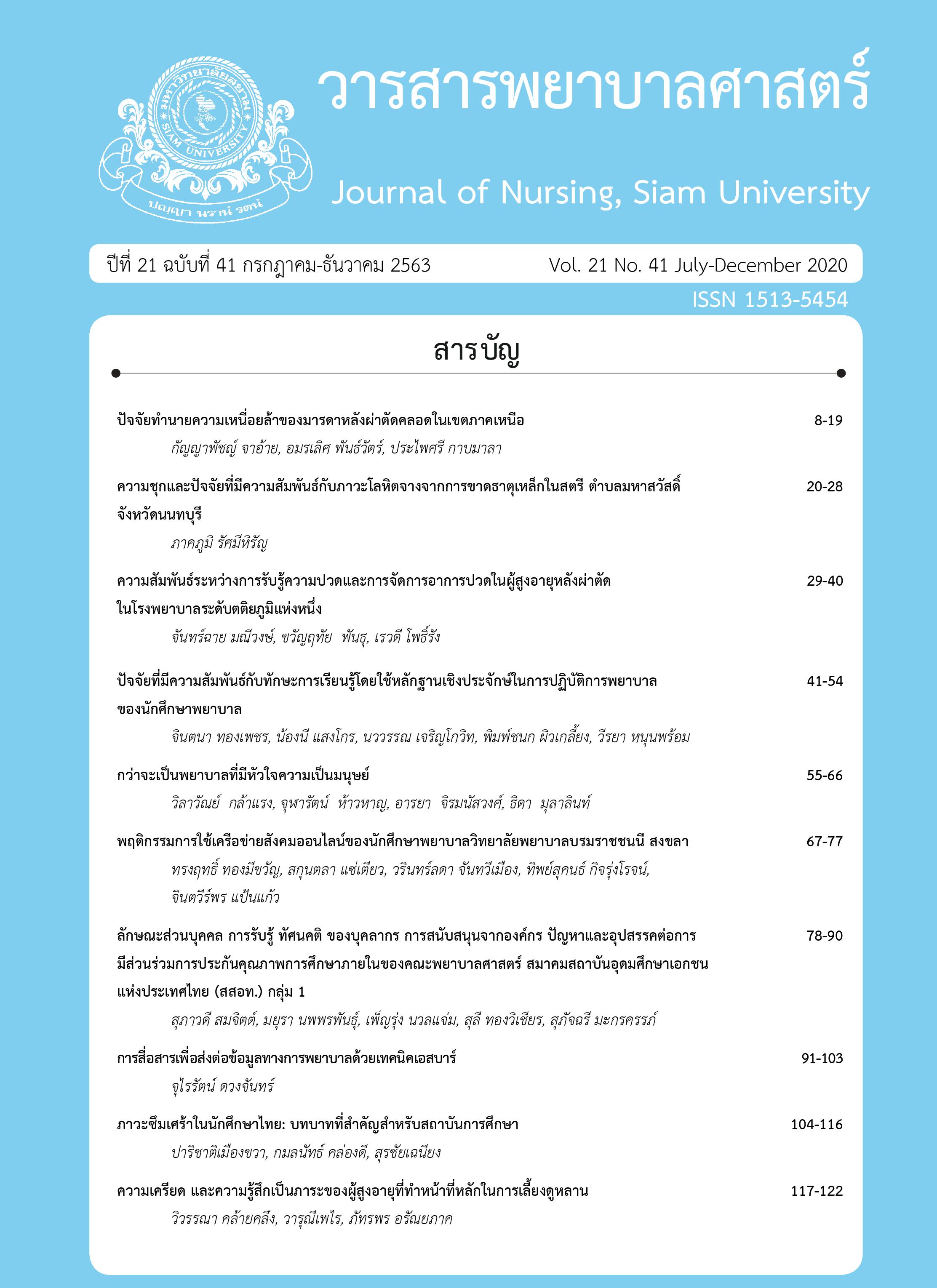The Correlation betweenPain Perception and Pain Management in elderly patients undergoing surgery at aTertiaryLevel Hospital
DOI:
https://doi.org/10.14456/jnsu.v21i41.243306Keywords:
Pain, Disturbances elderly, Pain management, ExpectationAbstract
The purpose of this research was to study the relationship among perception of disturbance, Level of pain, the severity of pain, expectation and pain management in elderly patients undergoing surgery. The sample group included 100 elderly patients after abdominal surgery at a Tertiary Level Hospital. Data were collected Patient’s Demographic Form, disturbance awareness questionnaire, Pain Intensity Scale, Severity of pain questionnaire, expectation questionnaire, and pain management questionnaire. Collected data were analyzed using descriptive statistics for frequency, percentage, mean, standard deviation and Pearson's range and correlation coefficient.
The results showed that perception of disturbance, level of pain after surgery was low correlated with pain management undergoing surgery at the level of.05 (r= .039, r= .404, respectively), and moderately positive expectation associated with pain management statistic significant at level of.05 (r =.616). Recommendation, the nurse should consider pain assessment and pain management for the elderly after surgery with a continuation and should apply several pain management methods for effectiveness to release pain.
References
เฉียบพลันในโรงพยาบาลรามาธิบดี. รามาธิบดีพยาบาลสาร, 15 (3),303-314.
จุฑารัตน์สว่างชัยและศรีสุดา งามขำ (2560). ความปวดของผู้ป่วยหลังผ่าตัดช่องท้องโรงพยาบาลสวรรค์ประชา
รักษ์. วารสารวิจัยทางวิทยาศาสตร์สุขภาพ, 11 (ฉบับพิเศษ), 1-11.
บุญใจ ศรีสถิตนรากูรม. (2553). ระเบียบวิธีการวิจัยทางพยาบาลศาสตร์. พิมพ์ครั้งที่ 5. กรุงเทพฯ : ยูแอนด์ไอ
อินเตอร์ มีเดีย.
สิริอร ข้อยุ่น, วริศรา ภู่ทวีและอาภา ศรีสร้อย. (2562). ผลของการใช้โปรแกรมการฟื้นตัวหลังผ่าตัดร่วมกับ
เครื่องพยุงเดินหลังผ่าตัด เพื่อป้องกันภาวะแทรกซ้อนหลังผ่าตัดในผ้ป่วยหลังผ่าตัดช่องท้อง. ศรี
นครินทร์เวชสาร, 34(4), 378 – 384.
บุญใจ ศรีสถิตนรากูรม. (2553). ระเบียบวิธีการวิจัยทางพยาบาลศาสตร์. พิมพ์ครั้งที่ 5. กรุงเทพฯ : ยูแอนด์ไอ
อินเตอร์ มีเดีย.
บรรจง จารุวงศ์. (2551). ความปวด การจัดการกับความปวด และผลของความปวดของผู้ป่วยหลังผ่าตัดช่อง
ท้อง ในโรงพยาบาลสรรพสิทธิประสงค์. วิทยานิพนธ์ปริญญา พยาบาลศาสตรมหาบัณฑิต
มหาวิทยาลัยราชธานี.
หน่วยงานห้องผ่าตัด. (2562). รายงานสถิติผู้ป่วยที่ได้รับการผ่าตัด. สุพรรณบุรี :โรงพยาบาลเจ้าพระยายม
ราช.
วัลยาพร คำมอญ, กนกพร สุคำวัง และโรจนี จินตนาวัฒน์. (2557). ผลของการพยาบาลตามทฤษฎี
ความสำเร็จตามจุดมุ่งหมายต่อการฟื้นสภาพหลังผ่าตัดของผู้สูงอายุที่ได้รับการผ่าตัดช่องท้อง. พยาบาลสาร, 41(2), 83 - 96.
อรพรรณ ไชยชาติ,วงจันทร์ เพชรพิเชฐเชียรและศศิธร พุมดวง. (2549). ความรุนแรงของ ความปวด ปัจจัย
สวนบุคลความคาดหวังและความพึงพอใจของผู้ป่วยต่อการจัดการกับความปวดหลังผ่าตัดช่องท้อง
ของทีมสุขภาพ. สงขลานครินทร์เวชสาร, 24(2), 101-109.
Dhesi, J. (2010). Improving outcomes in older people undergoing elective surgery. The
Journal of the Royal College of Physicians of Edinburgh, 40, 348-353.
Dodd, M., Janson, S., Facione, N., Faucett, J., Froelicher, E., Humphreys, J., et al. (2001).
Advancing the science of symptom management. Journal of Advanced Nursing, 33(5),
668-676
International Association for the Study of Pain (IASP) (2019). IASP pain terminology. April 23,
2019.
Momani, M. M. (2016). Gap Analysis between perceptions and expectations of medical-
surgical patients in a public hospital in Saudi Arabia. Medical and Practice, 25(1), 79-
84.
Stephan,M.F., & Esther. P.Z. 2019. Pain therapy to reduce perioperative complications.
Innovative Surgical Sciences, 4(4), 158 - 166.
Downloads
Published
How to Cite
Issue
Section
License
Content and information published in the Journal of Nursing, Siam University is the comment and responsibility of the authors.
Articles, information, images, etc. published in the Journal of Nursing. Siam University is the copyright of the Journal of Nursing, Siam University. If any person or entity wants to take all or part of it for publication for any purposes, please reference the Journal of Nursing, Siam University.



